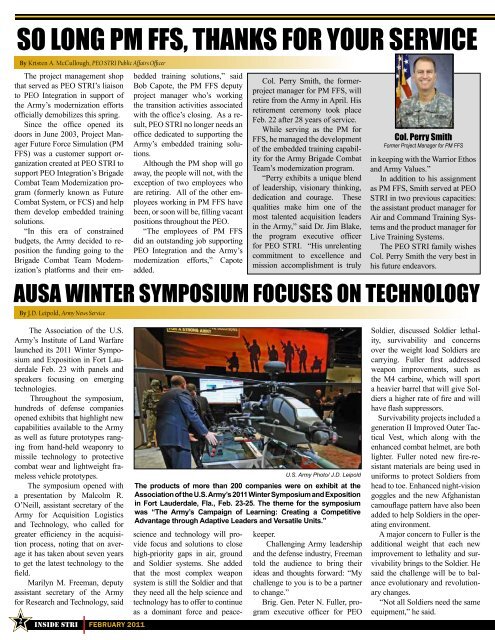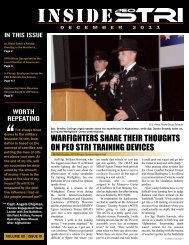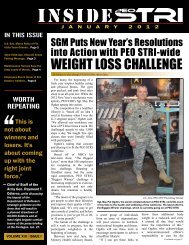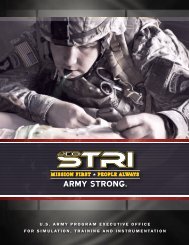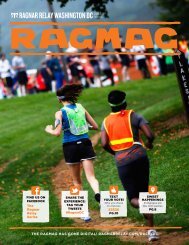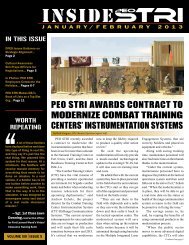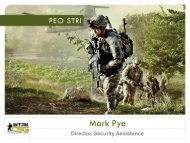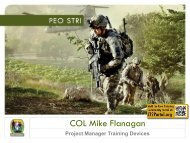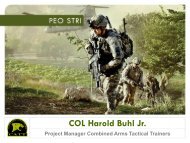InsIde - PEO STRI - U.S. Army
InsIde - PEO STRI - U.S. Army
InsIde - PEO STRI - U.S. Army
Create successful ePaper yourself
Turn your PDF publications into a flip-book with our unique Google optimized e-Paper software.
So Long PM FFS, Thanks for Your Service<br />
By Kristen A. McCullough, <strong>PEO</strong> <strong>STRI</strong> Public Affairs Officer<br />
The project management shop<br />
that served as <strong>PEO</strong> <strong>STRI</strong>’s liaison<br />
to <strong>PEO</strong> Integration in support of<br />
the <strong>Army</strong>’s modernization efforts<br />
officially demobilizes this spring.<br />
Since the office opened its<br />
doors in June 2003, Project Manager<br />
Future Force Simulation (PM<br />
FFS) was a customer support organization<br />
created at <strong>PEO</strong> <strong>STRI</strong> to<br />
support <strong>PEO</strong> Integration’s Brigade<br />
Combat Team Modernization program<br />
(formerly known as Future<br />
Combat System, or FCS) and help<br />
them develop embedded training<br />
solutions.<br />
“In this era of constrained<br />
budgets, the <strong>Army</strong> decided to reposition<br />
the funding going to the<br />
Brigade Combat Team Modernization’s<br />
platforms and their embedded<br />
training solutions,” said<br />
Bob Capote, the PM FFS deputy<br />
project manager who’s working<br />
the transition activities associated<br />
with the office’s closing. As a result,<br />
<strong>PEO</strong> <strong>STRI</strong> no longer needs an<br />
office dedicated to supporting the<br />
<strong>Army</strong>’s embedded training solutions.<br />
Although the PM shop will go<br />
away, the people will not, with the<br />
exception of two employees who<br />
are retiring. All of the other employees<br />
working in PM FFS have<br />
been, or soon will be, filling vacant<br />
positions throughout the <strong>PEO</strong>.<br />
“The employees of PM FFS<br />
did an outstanding job supporting<br />
<strong>PEO</strong> Integration and the <strong>Army</strong>’s<br />
modernization efforts,” Capote<br />
added.<br />
Col. Perry Smith, the formerproject<br />
manager for PM FFS, will<br />
retire from the <strong>Army</strong> in April. His<br />
retirement ceremony took place<br />
Feb. 22 after 28 years of service.<br />
While serving as the PM for<br />
FFS, he managed the development<br />
of the embedded training capability<br />
for the <strong>Army</strong> Brigade Combat<br />
Team’s modernization program.<br />
“Perry exhibits a unique blend<br />
of leadership, visionary thinking,<br />
dedication and courage. These<br />
qualities make him one of the<br />
most talented acquisition leaders<br />
in the <strong>Army</strong>,” said Dr. Jim Blake,<br />
the program executive officer<br />
for <strong>PEO</strong> <strong>STRI</strong>. “His unrelenting<br />
commitment to excellence and<br />
mission accomplishment is truly<br />
Col. Perry Smith<br />
Former Project Manager for PM FFS<br />
in keeping with the Warrior Ethos<br />
and <strong>Army</strong> Values.”<br />
In addition to his assignment<br />
as PM FFS, Smith served at <strong>PEO</strong><br />
<strong>STRI</strong> in two previous capacities:<br />
the assistant product manager for<br />
Air and Command Training Systems<br />
and the product manager for<br />
Live Training Systems.<br />
The <strong>PEO</strong> <strong>STRI</strong> family wishes<br />
Col. Perry Smith the very best in<br />
his future endeavors.<br />
AUSA Winter Symposium Focuses on Technology<br />
By J.D. Leipold, <strong>Army</strong> News Service<br />
The Association of the U.S.<br />
<strong>Army</strong>’s Institute of Land Warfare<br />
launched its 2011 Winter Symposium<br />
and Exposition in Fort Lauderdale<br />
Feb. 23 with panels and<br />
speakers focusing on emerging<br />
technologies.<br />
Throughout the symposium,<br />
hundreds of defense companies<br />
opened exhibits that highlight new<br />
capabilities available to the <strong>Army</strong><br />
as well as future prototypes ranging<br />
from hand-held weaponry to<br />
missile technology to protective<br />
combat wear and lightweight frameless<br />
vehicle prototypes.<br />
The symposium opened with<br />
a presentation by Malcolm R.<br />
O’Neill, assistant secretary of the<br />
<strong>Army</strong> for Acquisition Logistics<br />
and Technology, who called for<br />
greater efficiency in the acquisition<br />
process, noting that on average<br />
it has taken about seven years<br />
to get the latest technology to the<br />
field.<br />
Marilyn M. Freeman, deputy<br />
assistant secretary of the <strong>Army</strong><br />
for Research and Technology, said<br />
2<br />
Inside <strong>STRI</strong> February 2011<br />
U.S. <strong>Army</strong> Photo/ J.D. Leipold<br />
The products of more than 200 companies were on exhibit at the<br />
Association of the U.S. <strong>Army</strong>’s 2011 Winter Symposium and Exposition<br />
in Fort Lauderdale, Fla., Feb. 23-25. The theme for the symposium<br />
was “The <strong>Army</strong>’s Campaign of Learning: Creating a Competitive<br />
Advantage through Adaptive Leaders and Versatile Units.”<br />
science and technology will provide<br />
focus and solutions to close<br />
high-priority gaps in air, ground<br />
and Soldier systems. She added<br />
that the most complex weapon<br />
system is still the Soldier and that<br />
they need all the help science and<br />
technology has to offer to continue<br />
as a dominant force and peacekeeper.<br />
Challenging <strong>Army</strong> leadership<br />
and the defense industry, Freeman<br />
told the audience to bring their<br />
ideas and thoughts forward: “My<br />
challenge to you is to be a partner<br />
to change.”<br />
Brig. Gen. Peter N. Fuller, program<br />
executive officer for <strong>PEO</strong><br />
Soldier, discussed Soldier lethality,<br />
survivability and concerns<br />
over the weight load Soldiers are<br />
carrying. Fuller first addressed<br />
weapon improvements, such as<br />
the M4 carbine, which will sport<br />
a heavier barrel that will give Soldiers<br />
a higher rate of fire and will<br />
have flash suppressors.<br />
Survivability projects included a<br />
generation II Improved Outer Tactical<br />
Vest, which along with the<br />
enhanced combat helmet, are both<br />
lighter. Fuller noted new fire-resistant<br />
materials are being used in<br />
uniforms to protect Soldiers from<br />
head to toe. Enhanced night-vision<br />
goggles and the new Afghanistan<br />
camouflage pattern have also been<br />
added to help Soldiers in the operating<br />
environment.<br />
A major concern to Fuller is the<br />
additional weight that each new<br />
improvement to lethality and survivability<br />
brings to the Soldier. He<br />
said the challenge will be to balance<br />
evolutionary and revolutionary<br />
changes.<br />
“Not all Soldiers need the same<br />
equipment,” he said.


